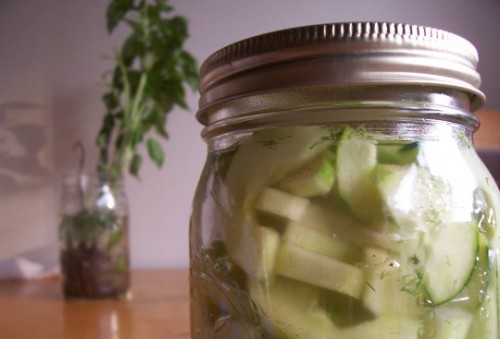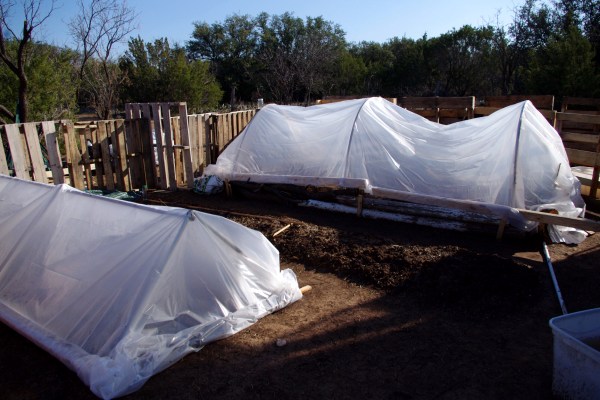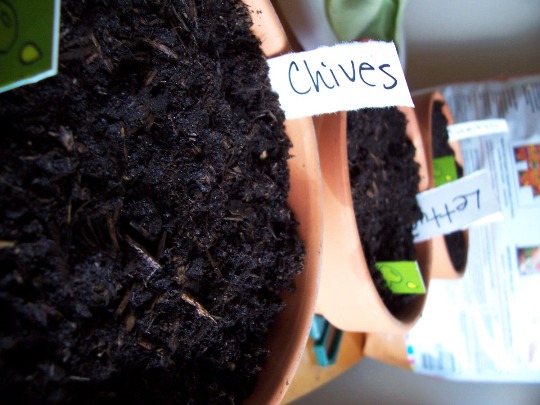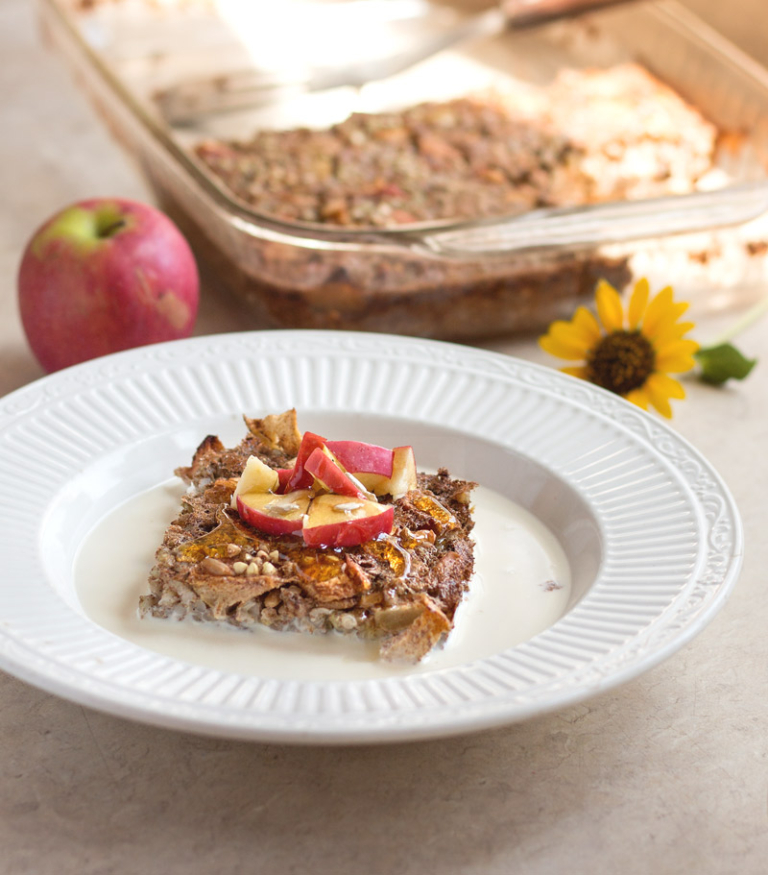Fermented Food for Beginners: Lacto-Fermented Vegetables

This is part 3 in a four part series. I renamed this series Fermented Food for Beginners in the hopes that it will encourage anyone who was intimidated about making their own ferments, as I was.
- Part 1: Introduction
- Part 2: Fermented Dairy
Before the advent of modern day canning most of our American fore mothers understood the process of lacto-fermentation. They had crocks of real sauerkraut, lacto-fermented cucumber pickles and other treasures such as beets, onions or garlic waiting out the winter in the root cellar.
Those countries with histories deeper than our own also traditionally fermented vegetables with simply salt, water and spices – knowing that the lactic acid produced would prevent the putrefication of these precious nutritional storehouses, keeping them fed through winter. Kimchi from Korea and cortido from Latin America are just two of the flavorful and delicious condiments not native to our own country.
When we lost touch with this food preservation technique we also lost touch with the unparalleled health benefits that came with them. Sally Fallon is a huge proponent of lacto-fermentation in her book Nourishing Traditions, and for good reason:
The proliferation of lactobacilli in fermented vegetables enhances their digestibility and increases vitamin levels. These beneficial organisms produce numerous helpful enzymes as well as antibiotic and anti carcinogenic substances. Their main by-product, lactic acid, not only keeps vegetables and fruits in a state of perfect preservation but also promotes the growth of healthy flora throughout the intestine.
After being completely overwhelmed by my first read through of Nourishing Traditions I waited months before making sauerkraut. The concept was foreign and intimidated me. Because I have grown up in a culture that thinks you have to pasteurize everything I wondered if I would poison my family.
If you are like I was – intimidated and a bit doubtful – then don’t be. You will know if a batch has gone bad. You will get used to, and even start to enjoy, the flavor of these healthful condiments. You will find that they are not much more difficult to assemble than a simple salad. You will actually want to keep a few jars/crocks on hand for health and flavor reasons.
To be honest I wasn’t wild about sauerkraut at first, nor the pickles that turned to mush. I found that I enjoyed bolder variations of sauerkraut such as kimchi and cortido. I also recently discovered how to make pickles keep their crunch a bit more – grape leaves. I’ve only tried one batch, adding the wild grape leaves from our own backyard, but they are crunchy and delicious instead of mushy and off-putting like my first few batches. It is the tannins in the grape leaves that are said to perform the delicious act.
So I would encourage you, if you were like me, to give lacto-fermentation a try. It is fairly simple, frugal and makes the most of your hard-earned real food. You can use whey as a starter culture in your brine, which Sally Fallon recommends in Nourishing Traditions.
I have not been using whey as of late and have yet to have a bad batch. I will leave you with two of my favorite flavors of lacto-fermented vegetables – cortido and dill pickles. I have come to love these little treasures so much that it makes it easy to eat them at two meals a day. Now all I need is that root cellar I dream of so that I can stock it full of giant crocks full of these tasty treasures.
Cortido
from Nourishing Traditions by Sally Fallon Recipe Notes: I sometimes leave out the carrots and halve the amount of onions. A struggle that I have is keeping the vegetables below the liquid level. I have yet to have a bad batch, but this can cause mold. One thing that I am considering purchasing from here is an airlock setup that allows the fermentation gases to escape while keeping air out. You can also purchase ready-made lacto-fermented vegetables here.
- 1 large cabbage, cored and shredded
- 1 cup carrots, grated
- 2 medium onions, quartered lengthwise and very finely sliced
- 1 tablesoon dried oregano
- 1/4 – 1/2 teaspoon red pepper flakes
- 1 tablespoon sea salt
- 4 tablespoons whey (if not available, use an additional 1 tablespoon salt)
- In a large bowl mix cabbage with carrots, onions, oregano, red chile flakes, sea salt and whey.
- Pound with a wooden pounder or a meat hammer for abou 10 minutes to release juices.
- Place in 2 quart-sized, wide mouth mason jars and press down firmly with a pounder or meat hammer until juices come to the top of the cabbage. The top of the cabbage mixture should be at least 1 inch below the top of the jars.
- Cover tightly and keep at room temperature for about 3 days before transferring to cold storage.
Pickled Cucumbers
from Nourishing Traditions by Sally Fallon Recipe Notes: For pickle slices simply cut cucumbers into 1/4 inch slice and cut back the fermentation time to 2 days instead of 3. A struggle that I have is keeping the vegetables below the liquid level. I have yet to have a bad batch, but this can cause mold. One thing that I am considering purchasing from here is an airlock setup that allows the fermentation gases to escape while keeping air out.
- 4-5 pickling cucumbers or 15-20 gherkins
- 1 tablespoon mustard seeds
- 2 tablespoons fresh dill, snipped
- 1 tablespoon sea salt
- 4 tablespoons whey (if not available, use an additional 1 tablespoon salt)
- 1 cup filtered water
- Wash cucumbers well and place in a quart-sized wide mouth jar.
- Combine remaining ingredients and pour over cucumbers, adding more water if necessary to cover the cucumbers. The top of the liquid should be at least 1 inch below the top of the jar.
- Cover tightly and keep and keep at room temperature for about 3 days before transferring to cold storage.
********** I also wanted to pass along a link to a great article Alyss wrote: Of Probiotics & Pickles.
So what about you… have you made any of these lacto-fermented vegetables? Which one is your favorite?
This post is a contribution to the In-Season Recipe Swap.





Thanks for the link! I absolutely love cortido.. delicious… mmmm. I like to make mine with the pineapple vinegar recipe in NT.. adds a whole sweet layer to the flavor.
One thing you can do to keep the vegetables under the brine is top the jar off with a whole (or part of a whole) cabbage leaf. Pack the jar with the shredded leaves and then stuff one or half of a cabbage leaf in and smoosh the shredded stuff down. Put the lid on and let ferment as usual. The whole leaf sometimes smells a little funky (sulfury like cooked cabbage can) but I’ve never had it mold. I just remove it when I put the jar in the fridge. Also, with Sally’s closed jar method of making kraut and pickles I’ve never had anything mold, just discolor if it was out of the brine.
Great post! 🙂
I also love cortido, and have yet to make a bad batch. I find that it spices up anything from eggs to guacamole to tacos! I introduced this to my 2nd born early on and he loves it!
Also, a tip for the pickles….when I followed Sally’s recipe the first few times, my pickles had a great flavor, but really lacked the “crunch”.
I had read on a forum a few years ago that putting an oak leaf or two, or a grape leave into the jar with the pickles will somehow keep the pickles crisp. It has something to do with tannins, but I have no idea of the science. Maybe Alyss would know?
But anyway, it totally worked! I used oak leaves just from the tree in my backyard and they were much crisper and delicious!
Hi,
I found your link from Kelly the Kitchen Kop and I’m glad I did. I have been searching for someone who’s been fermenting veggies. I’ve made sauerkraut three times including just last week. The first time I made it with just salt and it wasn’t so good but I was eating it. Then my fridge got too cold and froze my kraut so I threw it away. The second time I made it with whey and it was disgusting. I can eat many things but that kraut was too gross. Last week I made it again with salt (I’m a determined person) and it wasn’t the best but I’m hopeful it will get better with time. I know it’s good for you so we’ll eat it up.
I’m happy that you mentioned kimchi. I lived in Korea for a time and love kimchi. I was hestitant to make it because I figured it would never be as good as the kimchi I ate every day in Seoul. But you’ve given me hope! I’m going to try and make it soon.
I haven’t made pickles but I’m really excited about trying. I love pickles and so do my young boys. I’m going to make them without whey and I’ll try to find grape leaves .
Thanks for the inspiration!
You could buy the perfect pickler….www.perfectpickler.com. I found the site after I had my homebrewing husband fashion lids containing airlocks for my fermenting. You can buy plastic lids for mason jars and drill the appropriate size hole for the airlock (found at homebrewing shops online) and insert a rubber gasket then the airlock. My hubby has 5 gal. plastic food grade buckets with lids that he offered but I am reluctant to use plastic when it concerns food. I would love to have one of the kraut crocks from Lehman’s but don’t ferment enough of one thing at a time to justify the expense (yet!). Can’t wait to try your recipes! BTW, to keep cucumbers crunchy you can try adding about an inch of peeled horseradish to the jar, too.
Great post! Lacto-fermenting is exciting, but sometimes frustrating too. 🙂 I love sauerkraut made the ol’ fashioned way. So yummy. Thanks for being part of the carnival!
I’ve made the Cortido – and we LOVE it. I had a little trouble keeping the veggies below the liquid, but I screwed my canning lids on tight, and had no trouble with gases escaping. No mold developed, either.
Great post. I love making the dill pickles but decided to use small zucchini instead of cucumbers as I have plenty of them coming on in the garden. I think they look exactly like cucumber pickles and will taste like them too.
Can I use the bagged coleslaw mix?
For you newbies: Don’t give up on kraut as the taste only gets better with time. I make it twice a year and do not eat the first batch for 6 months since that is when the flavor just begins to be good.
My dad was telling me last week that my grandmother used to have a FIFTEEN GALLON crock that she used to make sauerkraut. Seriously. That is an amazing amount of kraut. We couldn’t find it or the smaller 5-gal crock she used to have. Bummer for me, I’d have loved to try my hand. I might get up the courage to try sour pickles this summer…I don’t know! Thanks for the good instructions.
I would love to try this one day!
What is the definition of “cold storage”, how cold will it need to be?
Thanks!
I have been culturing veggies all summer in glass mason jars, experimenting with all kinds of veggies, some molded some did not, and now none of the jars are molding because I am not opening them to ‘check’ on them like I was before, I just let them sit for as long as possible until I need to eat them. Once I open a jar for consumption I put it into the refrigirator.
I suggest highly suggest a book titled “Wild Fermentation” by Sondor Katz, he also has a website and is a ‘master’ krauter.
I also put seaweed in every batch of veggies instead of salt, very nutritious and there is no weird taste from the seaweed which just gets ‘sour’ with the rest of it.
My best batch to date? Try culturing beets, red onion and garlic (optional) and a bit of seaweed…
My natruopath put me on a diet that require making and eating cultured vegetables. No salt, I added probiotics. I pretty much followed a recipe from a book, The Ecology Diet which included cabbage, green apple, and garlic but added carrots too and celery. This recipe recommends adding probiotics from their website. I just went down to the health food store and looked for the same, and added them. It was a little scary, but I noticed when I ate them my allergy sore throat goes away, so did my craving for sugar. I think adding proibotics will help avoid botulism which is what I am afraid of. Also I don’t need any more salt in my diet. I can’t tolerate store bougth Keifer and may try leaving it out in the warm as described.
So, what do you eat these fermented veggies with? I have seriously never had them, except for kraut on a bratwurst…don’t think that recommended by NT!
I made saurkraut this summer but I can’t make myself eat it because it is so SOUR! I will try your recipes
Is it okay to use vegies from the store, even if you can’t find organic? It’s November in Michigan. There’s not much at all left in my garden.
I belong to a CSA in Colorado. The farmer’s wife held fermenting classes and I learned how to make fermented veggies of all kinds as well as Kim Chi. It took a year for my husband to eat them without protest but he is becoming used to seeing them on the top or side of all his garden salads, sandwiches, etc. I eat about 1/2 to 3/4 cup of some veggie I have fermented EVERY day and my bad digestive system is working better all the time. Try it, you will love it.
I just finished my first batch of fermented veggies and I’m HOOKED! They’re delicious with everything, and my digestion is already happier. I was amazed at how much more flavorful the veggies were, in comparison to pickles. HOORAY!
Can I use muscadine leaves to crisp pickles? I don’t have access to grape leaves.
I have been following Nourishing Traditions’ recipes and am so pleased with the results. I’ve done cabbage, beets (lacto fermented beets and since I love drinking the juice, decided to go straight for the beet kvass), and cucumbers.
I know they say to keep the cucumbers airtight for the three days or so that it is on the counter, but my glass mason jars with metal covers start to bulge. I’ve unscrewed them to let out some air and then re-tightened them. Is there a reason to use an airlock?
Since the old fashioned fermented cabbage was made in crocks that were not airtight, is it important to keep all air out?
Also, sometimes the brine/whey liquid is a little cloudy. It tastes fabulous, just wondering if it is yeast, and if it is good or not to drink.
Thirdly, I heard that if you are in very warm weather (I’m in Southern California and my kitchen can easily be mid to high 70s), that if you add some lemon juice also, that it will increase the acidity and keep mold from forming. I’ve tried it and it seems to work and is also tasty. I use the sea salt, whey, and lemon juice.
Great website – Thank you!
Hi Shannon! Hopefully this comment on an old post will get to you!
I just tasted my first batch of kimichi. Yum. A little spicy with red pepper flakes, but still yum.
Last summer, I had not yet tested the waters of home gardening. This is my first season. I had to dig around a bit, as I did remember you doing this series. Anyway, you may consider bringing it to the minds of your readers again with all of the delish veggies growing right now! I sure am glad that I dug up this post!
Thanks so much!
Hi Shannon. This is a great blog post. If we credit you and provide a link to your blog, could we have permission to reprint it on our membership site? Thanks for your consideration.
I’ve tried a few things for keeping the veggies submerged (I’m a fairly new pickler). My latest idea was to use a cabbage leaf (roughly torn to shape and size) with a suitable size quatz crystal to hold it down. I’ve used crystals in my work for a long time, so thought some of that type of energy could only enhance the pickles. It seems to work. Blessings to all you pickle makers, Shahzadi
I had Nourishing Traditions in my arms at the bookstore the other day, I put it back after I saw a recipe for brains in it…..I should have gotten it, I’m preparing books and recipes for spring when I start my first garden. I’m going back to get it 🙂
Shannon,
I am a home canner and have sucessfully made pickles and sauerkraut. This year we made 130 pounds of kraut and at one point I had 9 crocks of pickles going. It looks like you are fermenting in small batches. I would try using a crock. You can purchase new food grade crocks. 1/2 gallon or 1 gallon size might work best.
It is very easy to keep the food below the liquid level using crocks. Just use a food grade plastic bag filled with water. Put that on top of your veggies. You can weight it down by placing a small plate or bowl on top of it. If you need more weight put a canning jar filled with water on top of the plate or bowl. I have used this method with much sucess. I have never had any mold growing and never have lost a batch of kraut or pickles.
I want to try my hand at fermenting so that we have plenty of raw food in our diet during the winter months. Great site. Good luck
Hey, thank you for the great introduction.
I have a question regarding sauerkraut:
Once the sauerkraut has fermented at room temperature for 3 days, I put it in the fridge and after eating some of it, it seems like all the brine disappears, and then it starts tasting rotten. Is it necessary that the sauerkraut always stays under brine (even when opened?)?
I’ve just done a google search for “nourishing traditions sauerkraut” because of the very problem Christian has mentioned above!!! I had lovely tasting stuff, with a good inch or so of brine above the surface. But concerned that it was necessary to have “cool storage”, I put it in the fridge. The brine totally disappeared, and now my lovely sauerkraut smells horrible – it’s rotting! 🙁 I’ve nearly the same with my jar of beetroot – no sooner did I put it in the fridge, but white fuzzy stuff started growing on it. Help! What have I done wrong? I was so looking forward to having a jar of sauerkraut to dip into, and now it’s rotten!
I need help with a question about my fermentation attempt. I put cauliflower, carrot slices and garlic slices in two pint mason jars. I poured a brine of 2 c water and 1 T salt. After the 2nd day the jars were fizzy. I opened the tops each day to release any build-up of gas (afraid the jars might explode). the brine looked a bit cloudy, but I thought it was the fizz. I put them in the fridge. the brine still looks cloudy, but I don’t notice any more fizz. Is this normal? Will these be safe to eat? or did I do something wrong? thanks for any help out there!
Hello!
I have made the lacto-fermented carrots and lacto-fermented beets and the sauerkraut using the Nourishing Traditions recipes.
We were not very crazy about the carrots. Can someone clue me in to why she thought these would be a great start into lacto-fermented veggies??
The beets… I am getting ready to make another batch this weekend. This time I may use the cardamom seeds but NOT mixed into the beets. The hard, bite-y crunch with the great tasting beets was off-putting to say the least. Maybe that is my family’s personal tastes but I love cardamom just NOT like this. I wound up picking them out in order to eat the last of the jars. Has anyone tried putting a cinnamon stick in with the beets for some spice?? Guess I may have to experiment on my own a bit…
The sauerkraut was (and is) wonderful. We did try eating some after it was between 3 and 5 weeks old. It was not very sour and at that point the caraway seeds overpowered the kraut. But waiting a bit longer… I think it was at least another month and it was very sour, VERY tasty and the caraway was just a hint at this point.
I will have to try your mixed vegetables!
Blessings,
~Mrs. R
Mrs R – I have yet to try the carrots and have heard others say they were not great as well. I don’t know that I will ever do a lot of fermented root vegetables since those keep well in a cellar. I think it makes more sense for things like cabbages, cucumbers, tomatoes, etc.
Does cooking or freezing sauerkraut destroy the beneficial enzymes? I know yogurt that has been frozen destroys the probiotic properties.
Deborah – I believe that it does. I usually use sauerkraut as a condiment on warm foods so that it doesn’t lose its good properties.
i’m trying fermentation for the second time today. the first time, several years ago the kraut was very good, but for some reason ,i just never tried anything else. my question: some say a loose lid, you say a tight one, won’t they explode? please respond as soon as you can, my half gallon jar of garlic dills needs to know. thanks for your great site.
cindy
Cindy – With pickles I have done a tight lid, but be careful because if you let them ferment too long because I have had a jar shatter before :).